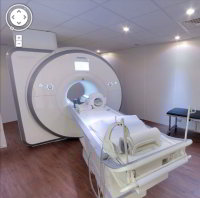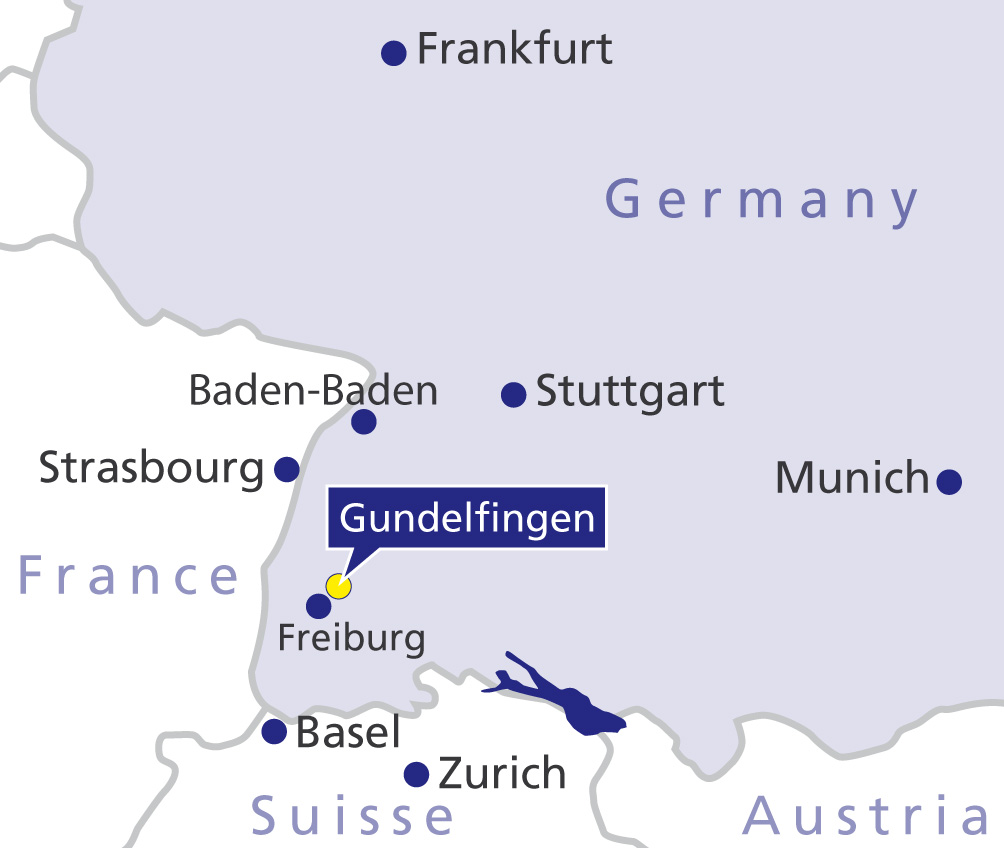Vertebral Fusion Surgery (Spondylodesis) as therapy for Spondylolisthesis (instability of vertebral spine)
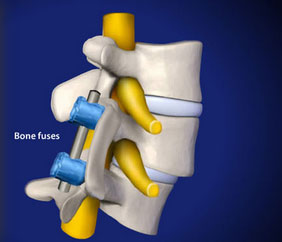 The fusion surgery of vertebrate bodies to stabilize displaced vertebrae has a long history. The human spine is designed to be mobile and elastic in every segment. After spinal fusion surgery mobility in this area is slightly reduced. © Viewmedica
The fusion surgery of vertebrate bodies to stabilize displaced vertebrae has a long history. The human spine is designed to be mobile and elastic in every segment. After spinal fusion surgery mobility in this area is slightly reduced. © Viewmedica
Spinal Fusion (Spondylodesis) is surgery to relieve the pain caused by unstable vertebrae in the human spine (Spondylolisthesis). In these patients the vertebrate bodies start to slip causing chronic back pain and symptoms of nerve compression. The fusion surgery of vertebrate bodies to stabilize displaced vertebrae has a long history.
Terminology
- Spondylolisthesis: Displacement of vertebrate bones interfering with the regular function of the spinal cord and spinal nerve roots.
- Spondylolysis: This is a defect of the vertebra (spinal bone) that may lead to a slipped vertebral body.
- Spondylodesis: Surgical fusion of vertebrate bones in order to stop displacement of vertebrae.
- Degenerative Spondylolisthesis: Age related displacement of vertebrate bones due to wear and tear in spinal discs, facet joints and joints of the spine.
- Slipped vertebra: Displaced vertebra (displaced bone in the spinal column).
- Congenital Spondylolisthesis: displaced vertebra resulting from a birth defect.
Spondylodesis: What does spinal fusion surgery really mean?
However spondylodesis is a critical surgery. The human spine is designed to be mobile and elastic in every single segment.
After spinal fusion surgery mobility in one or more mostly degenerated segments of the spine do no longer exist.
This spinal fusion will not interfere with the patients’ mobility or flexibility, particularly because the patient does already suffer reduced mobility from the symptoms of his spondylolisthesis. The linking of vertebrate bodies occurs in an area of the spine, where the patient will not feel any reduction in flexibility.
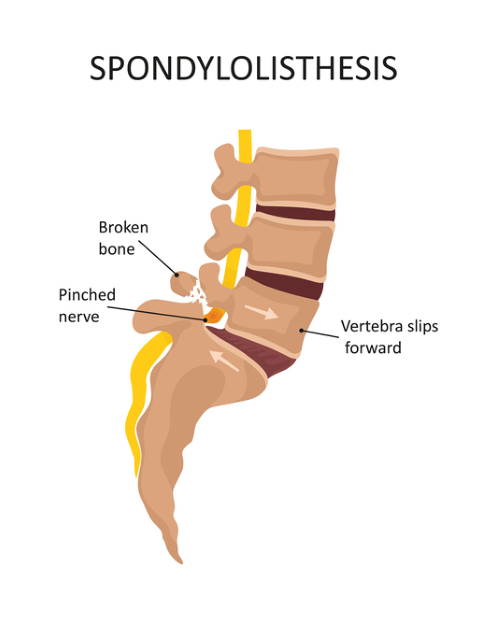 Spondylolisthesis in cause of a fracture: The L5 vertebrate body is slipping into the direction of the abdominal cavity putting pressure on the spinal cord. It will also cause facet-joint osteoarthritis.
Spondylolisthesis in cause of a fracture: The L5 vertebrate body is slipping into the direction of the abdominal cavity putting pressure on the spinal cord. It will also cause facet-joint osteoarthritis.
This will put an additional mechanical strain on the adjacent segments of the spine. This increase in mechanical strain in some areas of the spine has the potential to increase spinal disc degeneration and discomfort.
In the spine centre of orthopaedic Gelenk-Klinik the specialists established a wide range of treatments to treat spinal disc degeneration while preserving flexibility of the spine.
However in some cases of severe cases of slipping vertebrae (spondylolisthesis) there is no alternative to spinal fusion surgery in order to preserve pain free mobility for patients.
Slipping vertebrate bones: What is Spondylolisthesis?
Spondylolisthesis is the name given to the condition when a vertebrae slips forward into the abdominal cavity and pinches a nerve root. There are many reasons causing unstable vertebrae in the human spine. In 80% of all patients, spondylolisthesis is observed in the L5/S1 segment of the lumbar spine. This lumbar segment carries the body weight.
 X-ray image of a severe L5/S1 spondylolisthesis. The L5 and the S1 vertebrae are clearly displaced. If this radiological finding is combined with severe symptoms such as chronic back pain and reduced mobility a spinal fusion surgery (spondylodesis) might be the only treatment strategy left.
X-ray image of a severe L5/S1 spondylolisthesis. The L5 and the S1 vertebrae are clearly displaced. If this radiological finding is combined with severe symptoms such as chronic back pain and reduced mobility a spinal fusion surgery (spondylodesis) might be the only treatment strategy left.
The condition of spondylolisthesis can not be diagnosed through X-ray images alone: Many patients display a certain degree of instability of the lumbar spine. In some cases this diagnosis appears accidentally. It is, however no reason for alarm, if the patients do not display typical neurological signs of spinal instability. In many patients this condition is sufficiently compensated and no reason for alarm. Without having severe back pain or neurological conditions a slipped vertebrae is no critical condition. So for many patients the forward displacement of the vertebrate body is symptom free and does not require any particular medical attention.
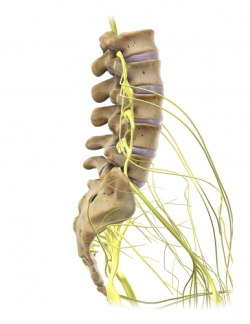 Lumbar Spine with nerve roots and spinal cord. Instability of vertebrae can pinch nerve roots or spinal cord, causing back pain, numbness and paralysis. © Viewmedica
Lumbar Spine with nerve roots and spinal cord. Instability of vertebrae can pinch nerve roots or spinal cord, causing back pain, numbness and paralysis. © Viewmedica
Typical symptoms of Spondylolisthesis
Sufferers of spondylolisthesis typically experience severe back pain and pain in the legs and feet. The reason for back pain and radiating pain is the pinched nerve. The vertebrate bodies contain the vertebrate cord, which is an essential part of the central nervous system.
If the alignment of the vertebrate bodies is unstable the spinal cord may suffer from pressure and pinching. This pressure leads to pain and loss of function. This pain is felt not only in the lumbar spin but also radiates into the organs and body parts that receive innervation from the pinched area of the spinal cord. Pain, numbness, and paralysis may be the result of unstable vertebrae.
Common Symptoms
- Stiffening and loss of mobility of the spine.
- Changing from a seated to a standing position becomes increasingly difficult.
- Patients find relief from back pain by bending forward.
- Changes in gate patterns - smaller steps - due to disturbed biomechanics of the pelvic area.
- Weakness of the legs.
- Disturbed function of urinary tract.
- After a period of time the physician may recognize an atrophy (reduction) of gluteal muscles due to reduced mobility and lack of use.
- Back pain ranging from intermittent back pain to constant pain, even episodes of sharp sciatic pain.
- Neurological symptoms such as numbness, paralysis and loss of reflexes.
- Due to the displaced vertebrae the pain may respond to coughing, sneezing, laughing or other kinds of movement involving the spine.
- Sitting and standing especially over an extended period of time may be difficult.
Types of Spondylolisthesis (Displaced vertebrae)
There are several rare congenital forms of spondylolisthesis as a birth defect. Most juvenile forms of displaced vertebrae that can be treated by observation and physiotherapy. The clinically most important and most common form of spondylolisthesis is the degenerative spondylolisthesis in adults later in their life.
Isthmic Spondylolisthesis
Isthmic Spondylolisthesis is caused by a fractured intravertebral joint during childhood. Most of these Isthmic Spondylolistheses are low grade.
Degenerative Spondylolisthesis
Degenerative Spondylolisthesis is mostly a disease of older adult patients. It often appears with one or all of the following findings:
- Facet joint osteoarthritis.
- Spinal disc degeneration.
- Weakness of the ligaments in the spinal column.
- Spinal stenosis due to the growth of Spondylophites in the spinal canal.
The prevalence of degenerative spondylolistheses in women and patients older than 60 is higher than in the average population. The degenerative spondylolisthesis has to be treated in the context of general, mostly age related degenerative diseases of the spine.
In cases of severe back pain we usually proceed with minimally invasive techniques of spine surgery , physiotherapy and other conservative therapies to reduce back pain. According to our experience pain resulting from slipped vertebrae can be controlled and treated for many years
When is a fusion surgery of the spine absolutely required?
- Danger of paralysis.
- Instabilities causing neurological symptoms such as loss of bladder control.
- Pain that can not be controlled with pain medication anymore.
Traumatic Spondylolisthesis
Traumatic spondylolisthesis is usually resulting from an accident.
Pathologic Spondylolisthesis
Pathological spondylolisthesis is usually resulting from a variety of causes; These include:
- Bone tumor.
- Metabolic bone disease (Osteoporosis).
- Vertebrate compression fracture in patients with osteoporosis.
How do we get excellent results in spinal fusion surgery?
Spinal fusion surgery is carried out by highly specialised surgeons at the Gelenk Klinik. It is performed through a very small incision which produces minimal scarring and speeds up the recovery time.
The first step of spinal fusion surgery is to remove the lamina (the portion of the vertebrae that covers the spinal cord). This immediately relieves the pressure on the nerve and therefore takes away the persistent pain.
Next the surgeon takes away any fractured bone that may be pinching the nerve root.
Bone grafts are then added at the sides of the spine. Over time these grafts will fuse (grow into) the spine, forming a solid bone.
Rods are secured to the spine with screws in order to keep the discs from slipping while the bone graft is healing.


